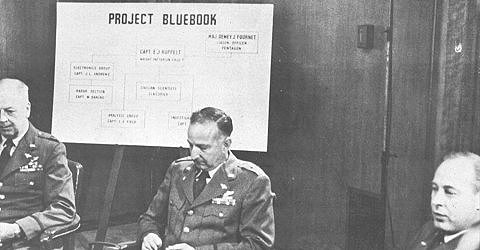Project Blue Book

Project Blue Book was the last, and by far the longest, of three studies conducted by the US Air Force into the phenomenon of unidentified flying objects. It was preceded by Project Sign (1948) and Project Grudge (1948–1952). Project Blue Book was headquartered at Wright-Patterson Air Force Base, Ohio, and was terminated 17 December 1969. Of a total of 12,618 sightings reported to Project Blue Book, 701 remained "unidentified."
Initially headed by Captain Edward J. Ruppelt, Project Blue Book was launched in March 1952 following a wave of sightings, including one by an Air Force pilot over Fort Monmouth, New Jersey, in September 1951. Over the next 17 years, Blue Book sifted through thousands of reports, but as the Air Force's interest in the phenomenon waned so did the number of staff working on the project. This often led to potentially interesting cases being inadequately researched and given facile explanations, with the result that proponents of the extraterrestrial hypothesis could claim that there was a cover-up in official circles. Meanwhile, Blue Book's astronomical consultant, J. Allen Hynek became increasingly convinced that a genuine and potentially important phenomenon lay behind some of the unresolved UFO reports.
Following a wave of sightings in 1965 and a renewal of public interest, the Air Force set up the Ad Hoc Committee to review Project Blue Book in the fall of that year. The Committee recommended that research on the problem be strengthened by involving universities. In March 1966, sightings of UFOs in Michigan by more than 100 witnesses, and the failure of Blue Book to come up with a credible explanation, prompted the House Armed Services Committee to hold an open hearing on UFOs, out of which came a decision to implement the Ad Hoc Committee's recommendation. A tender was put out to academic institutions to sift through the annals of Project Blue Book and come up with some definitive conclusions. Eventually, the contract went to the University of Colorado under the supervision of Edward Condon. In January 1969, the Condon Report appeared and concluded that any further official UFO investigations would be unjustified.
Cancellation of Blue Book: US Air Force statement
The decision to discontinue UFO investigations was based on an evaluation of a report prepared by the University of Colorado entitled, "Scientific Study of Unidentified Flying Objects;" a review of the University of Colorado's report by the National Academy of Sciences; previous UFO studies and Air Force experience investigating UFO reports during 1940 to 1969.
As a result of these investigations, studies and experience gained from investigating UFO reports since 1948, the conclusions of Project Blue Book were:
With the termination of Project Blue Book, the Air Force regulation establishing and controlling the program for investigating and analyzing UFOs was rescinded. Documentation regarding the former Blue Book investigation was permanently transferred to the Modern Military Branch, National Archives and Records Service, and is available for public review and analysis.
Since the termination of Project Blue Book, nothing has occurred that would support a resumption of UFO investigations by the Air Force. Given the current environment of steadily decreasing defense budgets, it is unlikely the Air Force would become involved in such a costly project in the foreseeable future.
There are a number of universities and professional scientific organizations that have considered UFO phenomena during periodic meetings and seminars. A list of private organizations interested in aerial phenomena may be found in "Encyclopedia of Associations," published by Gale Research. Interest in and timely review of UFO reports by private groups ensures that sound evidence is not overlooked by the scientific community. Persons wishing to report UFO sightings should be advised to contact local law enforcement agencies.


